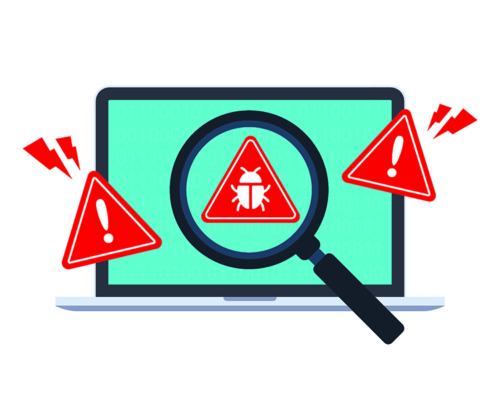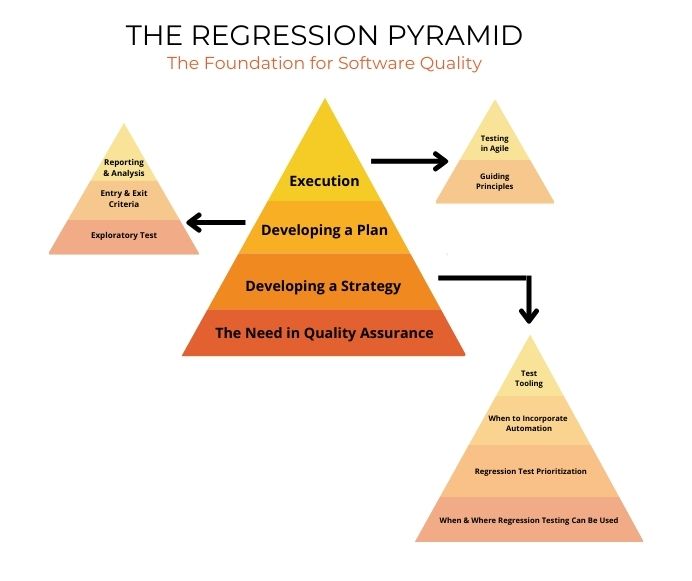
In November 2021, Tesla recalled 12,000 vehicles. The reason? All these vehicles had a bug that made them suddenly stop because of a false Forward Collision Warning (FCW).
Tesla averted a major crisis through the recall — these 12,000 drivers could have been severely injured because the company made a quality assurance and testing mistake and didn’t identify the bug.
Regression testing would have helped Tesla, and it can help other software development teams identify and fix software bugs. Let’s explore what regression testing is and how it works.
 Regression testing is essential to developing a piece of software that works as it should.
Regression testing is essential to developing a piece of software that works as it should.

 Automated testing will only work well when it produces a return on investment (ROI) in the long run and can be justified. Otherwise, implementing automation without the right tools, skills, and guidelines can lead to poor-quality results and unjustified expenses.
Automated testing will only work well when it produces a return on investment (ROI) in the long run and can be justified. Otherwise, implementing automation without the right tools, skills, and guidelines can lead to poor-quality results and unjustified expenses.
 Implementing manual regression testing is fairly easy and requires a lower upfront investment. Manual testing requires skilled testers and defined use cases, which the testers divide and conquer to generate a final report on what’s working and what needs fixing.
Implementing manual regression testing is fairly easy and requires a lower upfront investment. Manual testing requires skilled testers and defined use cases, which the testers divide and conquer to generate a final report on what’s working and what needs fixing.
 Different software and quality assurance teams complete regression tests using thorough regression test selection, ideally testing every change made.
Different software and quality assurance teams complete regression tests using thorough regression test selection, ideally testing every change made.
Understanding Regression Testing
Regression means “to go back to a previous or less developed state.” Regression testing takes the software into a previous version to see whether a new feature works the same way in the old version or whether a bug still occurs. The goal of regression testing is to ensure that any new software updates don’t introduce new bugs to a previously tested version. Regression testing is essential to developing a piece of software that works as it should.
Regression testing is essential to developing a piece of software that works as it should.
How Does Regression Testing Work?
The regression testing process is a continuous effort made by the software’s quality assurance team. After every sprint where the development team makes bug fixes or introduces new features, the quality assurance team starts regression testing. These teams use different regression testing tools and regression testing techniques to ensure software stability.When Should You Do Regression Testing?
Software development teams hand in their new software version to the quality assurance team for regression test planning and implementation when any of these three instances occur:- The software has new functionality. Developers have introduced new code, but they didn’t focus on ensuring that it’s compatible with the old code, so regression testing can help find any potential issues.
- The software’s functionality has been changed. Often, development teams modify or edit an existing feature. In this case, regression testing ensures that these new changes don’t damage the software’s overall performance.
- The software is integrated with a new product. When two pieces of software developed by different teams are integrated, new problems and incompatibilities could pop up. The regression testing process ensures the two software pieces work well together without any major issues.
Who Performs the Regression Testing Process?
The quality assurance team performs regression testing. They’re skilled at using various methods and regression testing tools to achieve the goal of a stable product. Generally, the quality assurance engineers who run the regression test suite are:- Testers who have not been involved in testing a particular feature previously, however, they can run test execution and test scripts on the identified test cases.
- Testers who have not been involved in functional test cases but are good at regression testing and can catch significant bugs.
- Testers who have previously done functional tests for the features that are being tested with regression.

(image source)
Some companies have in-house testing teams that perform software regression testing, prioritize test cases, and test new functionality with existing functionality. However, not every software development company has the capacity to conduct regression testing. For companies that don’t have these teams, specialist software quality improvement companies provide professional regression testing services that ensure an application runs the way it’s intended to.How Often Do You Have to Perform Regression Testing?
Software teams can run a regression testing suite whenever there’s an update. There are two different approaches to regression testing — manual regression and automated regression — that a testing team will decide to use based on the type of change or update.- After major functionality is added to the software, testers can run manual regression testing on prioritized or reusable test cases.
- After every bug fix, major new functionality, or integration, testers can use automated regression testing tools to test the entire regression test suite, including integration test cases.
The Most Common Types of Regression Testing
Testers can use several types of regression tests to make sure existing functionality works well with the new additions. Most teams won’t use all seven types of testing in their regression testing strategy. Instead, they might select the one that best suits the scenario, or they might use a mix — whatever it takes to verify that the software doesn’t have any bugs while ensuring an efficient process.Type #1: Corrective
Corrective regression testing is the simplest and most efficient type of testing. It’s only used when development has made minor bug fixes to the existing functionality, but no major functionality has been introduced. Because there have been minimal changes to the software, testers run regression tests on existing test cases without creating new test scripts. A test case is a set of actions testers perform to determine if an application meets all necessary software requirements and functions properly.Type #2: Selective
Selective regression testing starts with test case prioritization. This test is appropriate when development has made major or minor changes to selected modules within the software, and there’s no need to test modules that haven’t been changed.Type #3: Partial Regression Testing
Similar to selective regression testing, partial regression testing is used when a new piece of code is merged with existing code. Partial testing is only done on one part of the software, either because the rest of the software doesn’t need it or because the team is under a time crunch and needs to deploy the new release as soon as possible.Type #4: Complete Regression Testing
Complete regression testing runs the tests on the entire test suite. The team doesn’t prioritize any particular test case but uses the whole regression test suite to uncover any major issues and bugs. This type of testing is costly, which is why it’s used only when there are major changes in code or a big release. More often than not, complete regression testing is done through automating regression test cases rather than using manual methods.Type #5: Progressive
Progressive regression testing is only used when development has uncovered problems and made changes to software specifications. Because of these new changes, testers have to create new test cases, leading to some obsolete test cases. Testers then progressively run every new case to get test data while eliminating older, irrelevant cases.Type #6: Unit
Unit regression testing uses a more isolated approach to testing code changes. This type of test is best when a few modules have been changed, so testers run unit testing only on the changed code without considering any other dependencies on other code units.Type #7: Retest-all
Retest-all regression testing is one of the most time-consuming and expensive types of testing. It’s only used when development has completely reworked the software. Testers run test execution on every old and new test case, most often through automated test scripts, to ensure everything is working well.Regression Testing vs. Other Testing Processes
Regression testing is only one type of software testing. The other main types are functional testing, sanity testing, and smoke testing. Many teams use all these tests in conjunction with one another, running them in sequence or together, while others are more selective. Which type of testing a team uses depends on the overall strategy and the nature of the software.Functional Testing vs. Regression Testing
Functional testing is a must for development teams. This type of testing ensures that all software functionality works according to the specifications and requirements. For example, functional testing ensures that a “Sign Up” button takes the user to the sign-up page for the product rather than performing a different function. Regression testing is only useful when new changes have been made, but functional testing must always be done. In some cases, functional and regression testing work together. For example, during regression testing, testers will use the test cases from functional testing.Sanity Testing vs. Regression Testing
Sanity testing is done when developers have added a new module to the software or made significant code changes. This test ensures that the software is stable enough to carry out the intended functions before the quality assurance team moves ahead with other types of testing. If a piece of software doesn’t pass sanity testing, it has to be rejected and placed back into development so the development team can make fixes. Because regression testing is executed to see the impact of new modules or features, it is a superset of sanity testing.Smoke Testing vs. Regression Testing
Similar to sanity testing, smoke testing is performed on core software functionalities to see whether they’re working fine. If the software doesn’t pass the smoke test or build-verification test, it is rejected and cannot be tested further without the development team fixing it. Software regression testing is performed on more stable builds of the software, so smoke testing can be done before regression testing.Manual vs. Automated Regression Testing
When teams start building software, and it’s still small, they have fewer test cases. In these scenarios, they might use manual testing. But as the software grows and changes and regression testing costs grow, the range of test cases also grows. At this point, it takes too long to perform testing manually. That’s when some teams will use automation testing to ensure they can test quickly and release the software in a timely manner.Implementing Automated Regression Testing
Automated regression testing plays a crucial role in ensuring quick releases. Using a test automation tool, teams can run through test cases faster, identify what areas need improvement, fix them, and release the software. To properly automate regression testing, teams need these elements:- The right tools, can be costly but are crucial in scaling up regression testing.
- The right skills because some automation tools require specific coding skills. Software companies should hire new people or train current ones if they want to automate regression testing, and no one on the existing team has the necessary coding skills.
 Automated testing will only work well when it produces a return on investment (ROI) in the long run and can be justified. Otherwise, implementing automation without the right tools, skills, and guidelines can lead to poor-quality results and unjustified expenses.
Automated testing will only work well when it produces a return on investment (ROI) in the long run and can be justified. Otherwise, implementing automation without the right tools, skills, and guidelines can lead to poor-quality results and unjustified expenses.
Advantages of Automated Regression Testing
- Saves time and resources. A good automated testing tool runs through test cases quicker than manual testing and saves a lot of resources in the process. It also generates a report on the performance of test cases in a matter of hours, while manual testing takes days.
- More likely to be error-free. Because there are fewer instances of human intervention, automated testing is more likely to have fewer human errors than manual testing.
- No need to prioritize test cases. If you’re running a complete regression test, then automated testing can do it quickly without the need to prioritize test cases.
Drawbacks of Automated Regression Testing
- It’s costly. Automated testing requires an upfront investment in tools and human skills.
- It takes longer to deploy. Before starting automated testing, teams have to create specific guidelines on how it will work, which can delay the regression testing process.
- Needs constant updating. When developers change the software environment, all the test cases also need updating, which increases the complexity and costs.
Implementing Manual Regression Testing
Manual testing is a method of regression testing that uses skilled testers to approach the product exactly like a user would and see what the overall experience looks like. This testing approach is used by smaller start-ups that are still building their software and test cases. Implementing manual regression testing is fairly easy and requires a lower upfront investment. Manual testing requires skilled testers and defined use cases, which the testers divide and conquer to generate a final report on what’s working and what needs fixing.
Implementing manual regression testing is fairly easy and requires a lower upfront investment. Manual testing requires skilled testers and defined use cases, which the testers divide and conquer to generate a final report on what’s working and what needs fixing.
Advantages of Manual Regression Testing
- Lower investment. Manual testing doesn’t require a sophisticated tool to run test cases quickly, so it costs less.
- Personalized testing. Because skilled testers go through each test case and imagine the user’s perspective, it’s more thorough.
Drawbacks of Manual Regression Testing
- Takes too long. Because it’s manual, this type of regression testing takes longer than automated testing. It takes days to run through the necessary test cases rather than hours.
- Prioritization of test cases. It’s almost impossible to do a complete regression test on all test cases through manual regression testing, so testers have to prioritize the most critical cases.
- Low reusability. Continuous testing through manual testing is more challenging because the priority of test cases changes, and if testers went through a test case in the previous release, they might not have time to reuse the same test case in the next release.
Understanding Regression Test Case Selection
Choosing the right regression test cases is crucial because testing teams can’t test everything right away. Most software development teams and testers take these elements into account when prioritizing regression test cases:- Software modules that recently experienced code changes
- Modules that are more likely to have bugs and errors
- Modules that comprise the core functionality of a software piece
- Modules that are of higher priority to the business and contribute to revenue
- Modules that have recently been integrated with other software or modules
- Modules that are more visible to end-users than those running in the background
Conclusion
Regression testing is a crucial testing strategy for software teams. It allows for quick identification of bugs and issues within the software’s newest features and reveals how they impact existing functionality. While there are many types of regression tests, companies can choose the ones that make the most sense for their business to save time and money. If you’re a company or developer that needs regression testing performed, XBOSoft can help. Our team provides high-quality testing and quality assurance services designed to match your in-house software development needs. With exceptionally deep expertise and a wide range of services, XBOSoft is ready to help you deliver incredible software. Learn more today. Let’s look at a regression testing example to see how the process works. Imagine you’re working on new productivity software, and you’re ready to release version 10.2. Performing regression testing in a standard way would look something like this:- Introduce new features and bug fixes in version 10.2 without releasing to current users may be better.
- Integrate the new functionality of version 10.2 with the features and functionalities of version 10.1.
- This integration could cause new bugs and problems that the development team might not have anticipated or thought of.
- The software testing team tests whether these two versions are compatible and makes any bug or functionality fixes.
- Once all fixes have been made, the software team updates production or current users to version 10.2.
 Different software and quality assurance teams complete regression tests using thorough regression test selection, ideally testing every change made.
Different software and quality assurance teams complete regression tests using thorough regression test selection, ideally testing every change made.
Need Help with Your Regression Testing Strategy?
Learn MoreMost Popular
 |
A Quick Introduction To Jira By: Jimmy Florent | |
 |
Visual Regression Testing Market Challenges and Opportunities By: Philip Lew | |
 |
Agile Testing Solution Market Continues to Grow – What Are The Key Challenges? By: Philip Lew | |